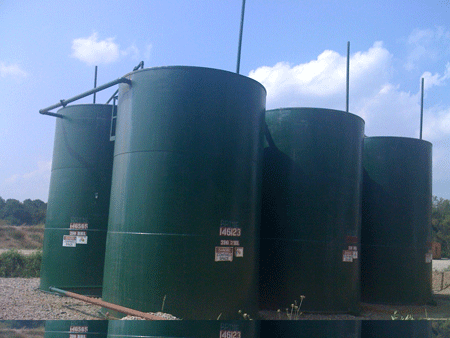Flowback water
From Wikimarcellus

The frac load recovery can be anywhere from 15-40% percent of the volume of fluid that is injected, that is forced down a well, and it flows back over a period of 3-4 weeks after fracing--most of it within 7 to 10 days. More than half of the frac fluid remains in the formation. At a certain point there is a transition between primarily recovering frac fluid to that of produced water. Usually this point is difficult to distinguish, yet may be discerned from the different chemical signatures of the frac water versus the naturally occurring water produced by the formation. A typical flowback of frac fluids might run 40,000 bbl. After the initial 3-4 week post-fracing recovery of fluids, an additional 10,000 to 30,000 bbl of produced water may flow for up to two years.
Flowback water may be characterized as having high salinity and total dissolved solids (TDS). It is laden with the same fracing chemicals that were pumped into the well, in addition to any unique contaminants that are present in the rock formation water deep below. In addition to natural salinity of water in the formation, any fresh water that is forced down a well, when it is fraced, will tend to dissolve salts in the formation thus giving the recovered water very high salinity.
The retuning fluid is generally collected in metal tanks or else open pools, lagoons or pits lined with one or more layers of plastic. These are then pumped dry, and water is usually either recycled for fracing additional wells or else trucked off site to a waste water disposal facility. Containment pits, or open-air ponds that are lined with plastic, can become points of failure. Occasionally, liners get cracked or damaged. Contaminated fluids can then leach into ground water.
Increasingly, drillers are shifting to closed loop systems as the preferred method of handling flowback water.
The Pennsylvania Department of Environmental Protection has formed a partnership with the oil and gas industry to research and develop innovative new methods of recycling and treating flowback water.
Municipal sewage disposal plants were never designed to handle recovered fracturing fluids or produced water, yet existing and planned treatment facilities are believed to be adequate at least for the current level of Marcellus shale drilling in Pennsylvania.
A large percentage of flowback water is reused before it is released back into the environment. Roughly 60% gets reused, and this percentage is increasing. When multiple wells are in close proximity to each other, recycling the water is more cost effective. The amount of iron in the water, suspended solids, bacteria and other contaminants also help determine whether reuse is a practical alternative.
Industry leader Range Resources reuses 100% of its flowback water. All flowback water is either reused or treated by the industry.

